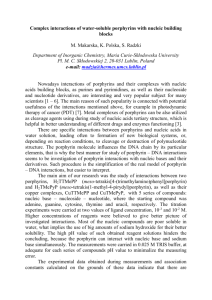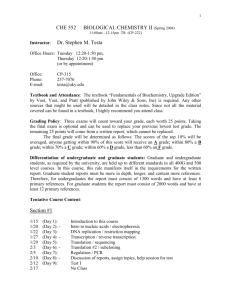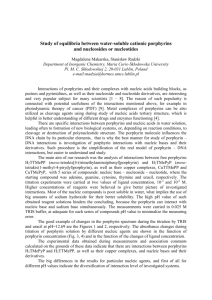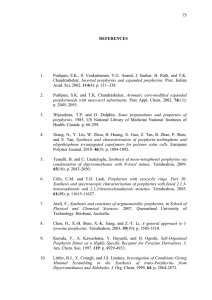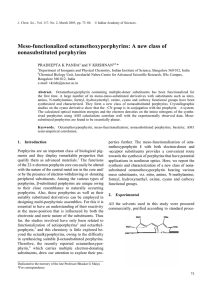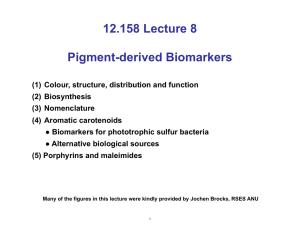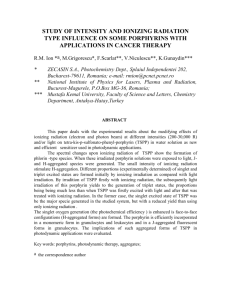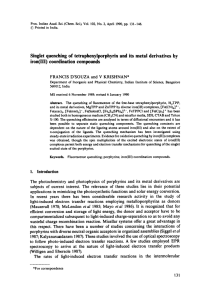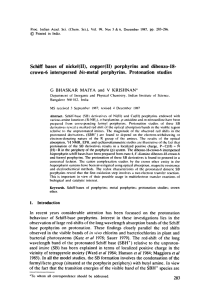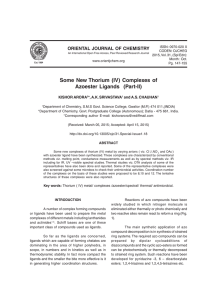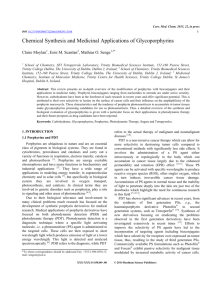spectrophotometric study of water
advertisement
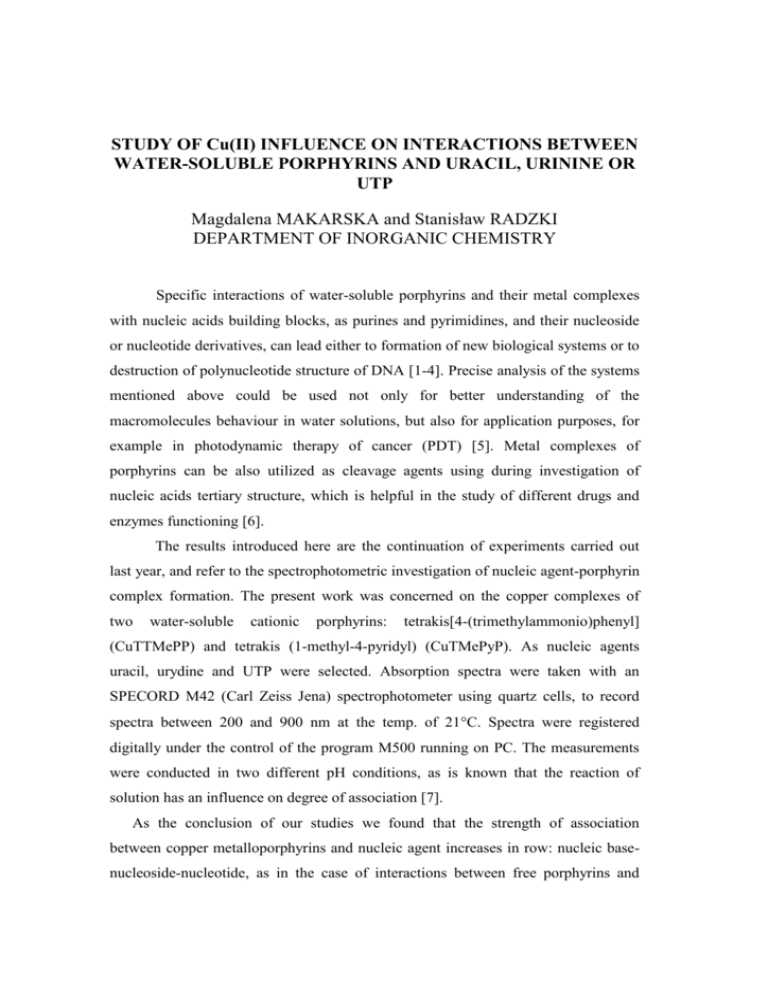
STUDY OF Cu(II) INFLUENCE ON INTERACTIONS BETWEEN WATER-SOLUBLE PORPHYRINS AND URACIL, URININE OR UTP Magdalena MAKARSKA and Stanisław RADZKI DEPARTMENT OF INORGANIC CHEMISTRY Specific interactions of water-soluble porphyrins and their metal complexes with nucleic acids building blocks, as purines and pyrimidines, and their nucleoside or nucleotide derivatives, can lead either to formation of new biological systems or to destruction of polynucleotide structure of DNA [1-4]. Precise analysis of the systems mentioned above could be used not only for better understanding of the macromolecules behaviour in water solutions, but also for application purposes, for example in photodynamic therapy of cancer (PDT) [5]. Metal complexes of porphyrins can be also utilized as cleavage agents using during investigation of nucleic acids tertiary structure, which is helpful in the study of different drugs and enzymes functioning [6]. The results introduced here are the continuation of experiments carried out last year, and refer to the spectrophotometric investigation of nucleic agent-porphyrin complex formation. The present work was concerned on the copper complexes of two water-soluble cationic porphyrins: tetrakis[4-(trimethylammonio)phenyl] (CuTTMePP) and tetrakis (1-methyl-4-pyridyl) (CuTMePyP). As nucleic agents uracil, urydine and UTP were selected. Absorption spectra were taken with an SPECORD M42 (Carl Zeiss Jena) spectrophotometer using quartz cells, to record spectra between 200 and 900 nm at the temp. of 21C. Spectra were registered digitally under the control of the program M500 running on PC. The measurements were conducted in two different pH conditions, as is known that the reaction of solution has an influence on degree of association [7]. As the conclusion of our studies we found that the strength of association between copper metalloporphyrins and nucleic agent increases in row: nucleic basenucleoside-nucleotide, as in the case of interactions between free porphyrins and nucleic compounds. What is more, association constants between pyrimidines and Cu(II) complexes are much higher than constants calculated for systems pyrimidinefree porphyrin – this fact testify for formation of the bond, between donor oxygen atoms of pyrimidine bases and the central atom Cu(II), which has an influence on the strenght of generated associates. 0 0 . 1 0 0 . 1 P P e M T T u C 7 . 2 1 = H p 7 1 + 3 6 3 3 = A 5 7 . 0 A P P e M T T u C 4 . 2 1 = H p 0 3 + 7 0 4 9 = 5 7 . 0 0 5 . 0 0 5 . 0 5 2 . 0 5 2 . 0 0 0 . 0 0 5 0 1 0 2 5 1 5 2 0 3 5 3 4 0 1 * l i c a r u c M 0 0 . 0 0 . 0 5 . 0 0 . 1 5 . 1 0 0 . 1 0 0 . 1 A P P e M T T u C 7 . 2 1 = H p 3 2 + 1 9 1 1 = 5 7 . 0 5 7 . 0 0 5 . 0 5 2 . 0 5 2 . 0 0 0 . 0 0 5 0 1 5 1 0 2 5 2 0 3 5 3 0 0 . 0 0 . 0 5 . 2 0 . 3 5 . 3 P P e M T T u C 4 . 2 1 = H p 4 1 + 3 2 1 0 3 = A 0 5 . 0 0 . 2 4 0 1 * l i c a r u c M 5 . 0 0 . 1 5 . 1 0 . 2 5 . 2 0 . 3 5 . 3 4 4 0 1 * e n i d y r u c M 0 1 * e n i d y r u c M 0 0 . 1 0 0 . 1 P P e M T T u C 7 . 2 1 = H p 3 1 + 1 2 0 4 = A 5 7 . 0 5 7 . 0 0 5 . 0 0 5 . 0 5 2 . 0 5 2 . 0 0 0 . 0 0 5 0 1 5 1 0 2 5 2 0 3 5 3 P P e M T T u C 4 . 2 1 = H p 3 1 + 3 2 1 7 5 = A 0 0 . 0 0 . 0 5 . 0 0 . 1 5 . 1 4 0 1 * P T U c M 0 . 2 5 . 2 0 . 3 5 . 3 4 0 1 * P T U c M Fig. 1. The results of fitting procedure concerning the absorbance changes of Soret band during the titration of CuTTMePP complex by uracil, uridine and UTP, at pH = 12.4 and 12.7. The black points represent experimental data, whereas the curves are generated by the fitting procedure. References: 1. R. F. Pasternack, E. J. Gibbs, A. Gaudemer; J. Am. Chem. Soc., 1985, 107, 8179. 2. R. F. Pasternack, E. J. Gibbs, J. J. Villafranca; Biochemistry, 1983, 22, 5409. 3. P. Kubat, K. Lang, P. Anzenbacher; J. Chem. Soc., Perkin Trans. 1, 2000, 933. 4. M. Tabata, M. Sakai, K. Yoshioka; Analytical Sciences, 1990, Oct, 6, 651. 5. K. Driaf, R. Granet, P. Krausz; Can. J. Chem., 1996, 74, 1550. 6. G. Pratviel, J. Bernadou, B. Meunier; Angew. Chem. Int. Ed. Engl., 1995, 34, 746. 7. M. Sirish, H. J. Schneider; Chem. Commun., 2000, 23.


